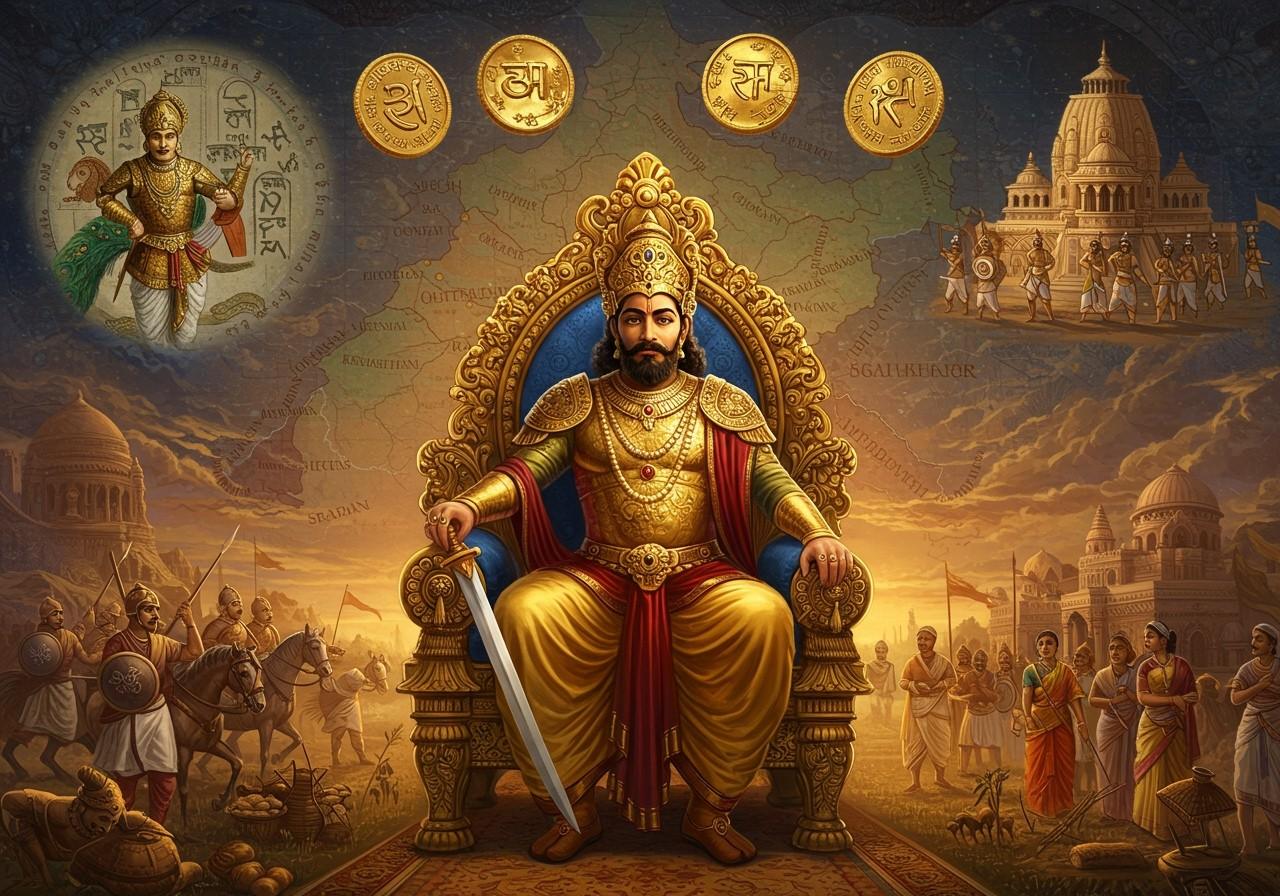
Chandragupta II, a prominent Gupta emperor, reigned from approximately 375 CE to 415 CE. His rule is considered a golden age in Indian history, marked by significant territorial expansion, efficient administration, and a flourishing of art, culture, and science. This period saw advancements in various fields, echoing the broader Gupta era (mid-3rd to mid-6th century CE) known for its cultural and intellectual achievements, trade connections with the Han Dynasty and Roman Empire, and advancements in arts, science, mathematics, literature, and Buddhism.
Early Life and Rise to Power
Born into the Gupta dynasty, Chandragupta II’s early life was shaped by his father, Samudragupta. He navigated political challenges through strategic alliances, notably his marriage to Princess Kuberanaga of the Naga dynasty, which solidified his claim to the throne. This strategic alliance not only strengthened his position but also expanded the empire’s influence and reach.
Expansion of the Gupta Empire
Chandragupta II significantly expanded the Gupta Empire through military campaigns and diplomatic maneuvers. His conquest of the Shaka territories in western India was a major achievement, bringing valuable trade routes and ports under Gupta control. This expansion integrated new territories into the empire, contributing to economic prosperity and further solidifying Gupta dominance in the region. These conquests also gave the empire access to valuable resources and strategic locations, boosting its overall power and influence.
Administration and Governance
Chandragupta II’s administration was characterized by a well-structured bureaucracy, efficient revenue collection, and a focus on local governance. His council of ministers, the Mantri Parishad, played a key role in policy-making. This structured approach ensured the smooth functioning of the empire and facilitated its growth and stability. A well-organized administrative system allowed for effective governance and resource allocation across the vast Gupta territories.
Cultural and Economic Prosperity
Chandragupta II’s reign witnessed remarkable cultural and economic growth. He patronized scholars, poets, and artists, leading to a flourishing of Sanskrit literature and advancements in various fields of knowledge. This period saw the rise of prominent figures like Kalidasa, further enriching the cultural landscape of the empire. Trade flourished along the Silk Road and maritime routes, contributing to the empire’s economic prosperity. The empire’s economic strength was further supported by a stable monetary system, which facilitated trade and commerce both within the empire and with other regions.
Military Organization
The Gupta military under Chandragupta II was a formidable force, comprising infantry, cavalry, and war elephants. The army utilized advanced weaponry and tactics, contributing to the empire’s military successes. Strong fortifications and a powerful navy protected the empire’s borders and maritime trade routes, ensuring security and stability. The navy’s strength was particularly important for safeguarding maritime trade and projecting power across the Indian Ocean.
Legacy and Succession
Chandragupta II’s legacy is one of prosperity, cultural achievement, and strong governance. He was succeeded by his son, Kumaragupta I, who continued the Gupta dynasty’s reign. Inscriptions, coins, and other historical sources provide valuable insights into his rule. His reign laid the foundation for continued Gupta dominance and is remembered as a high point in ancient Indian history. His contributions to the empire’s golden age are still studied and celebrated today, highlighting his significant impact on India’s historical trajectory.
Connecting to History with Poojn.in
At Poojn.in, we offer a variety of products that connect you with India’s rich cultural heritage, particularly the Gupta period, a time of significant artistic and cultural development from the mid-3rd to mid-6th century CE.
-
Copper and Bronze Items: Explore our collection of pure copper and bronze items, reminiscent of vessels used during the Gupta era. These pieces not only serve as beautiful decorative items but also offer a glimpse into the craftsmanship and artistry of the time. Discover our copper and bronze collection here.
-
Traditional Incense and Dhoop: Immerse yourself in the authentic fragrances of hand-crafted incense and dhoop, made using traditional methods passed down through generations. These aromatic offerings enhance your spiritual practices and create a serene atmosphere. Experience the traditional scents here.
-
Religious Texts and Books: Delve deeper into the history and spirituality of the Gupta period with our selection of religious texts and books. These resources offer valuable insights into the beliefs, practices, and cultural context of this era. Explore our collection of texts and books.
-
Puja Items: Find everything you need for traditional worship with our comprehensive puja sets. These sets include all the essential items required for performing pujas and rituals, helping you connect with ancient practices. Find your perfect puja set here.
Visit www.poojn.in to explore our complete collection. We offer pan-India delivery and detailed product information to help you make the best choices.
Conclusion
Chandragupta II’s reign stands as a testament to effective leadership, strategic expansion, and a flourishing of culture and intellect. His contributions to the Gupta Empire’s golden age continue to inspire and resonate with us today, reminding us of a pivotal period in Indian history. His reign solidified the Gupta Empire’s position as a major power and left an enduring legacy of artistic, cultural, and intellectual achievements.


